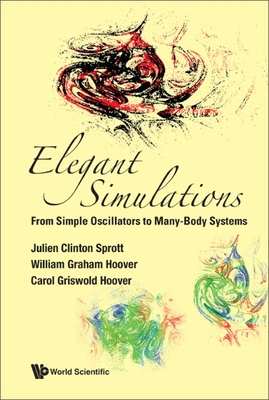Elegant Simulations: From Simple Oscillators to Many-Body Systems

Elegant Simulations: From Simple Oscillators to Many-Body Systems
A recent development is the discovery that simple systems of equations can have chaotic solutions in which small changes in initial conditions have a large effect on the outcome, rendering the corresponding experiments effectively irreproducible and unpredictable. An earlier book in this sequence, Elegant Chaos: Algebraically Simple Chaotic Flows provided several hundred examples of such systems, nearly all of which are purely mathematical without any obvious connection with actual physical processes and with very limited discussion and analysis.
In this book, we focus on a much smaller subset of such models, chosen because they simulate some common or important physical phenomenon, usually involving the motion of a limited number of point-like particles, and we discuss these models in much greater detail. As with the earlier book, the chosen models are the mathematically simplest formulations that exhibit the phenomena of interest, and thus they are what we consider 'elegant.'
Elegant models, stripped of unnecessary detail while maximizing clarity, beauty, and simplicity, occupy common ground bordering both real-world modeling and aesthetic mathematical analyses. A computational search led one of us (JCS) to the same set of differential equations previously used by the other (WGH) to connect the classical dynamics of Newton and Hamilton to macroscopic thermodynamics. This joint book displays and explores dozens of such relatively simple models meeting the criteria of elegance, taste, and beauty in structure, style, and consequence.
This book should be of interest to students and researchers who enjoy simulating and studying complex particle motions with unusual dynamical behaviors. The book assumes only an elementary knowledge of calculus. The systems are initial-value iterated maps and ordinary differential equations but they must be solved numerically. Thus for readers a formal differential equations course is not at all necessary, of little value and limited use.
PRP: 1097.40 Lei
Acesta este Pretul Recomandat de Producator. Pretul de vanzare al produsului este afisat mai jos.
987.66Lei
987.66Lei
1097.40 LeiLivrare in 2-4 saptamani
Descrierea produsului
A recent development is the discovery that simple systems of equations can have chaotic solutions in which small changes in initial conditions have a large effect on the outcome, rendering the corresponding experiments effectively irreproducible and unpredictable. An earlier book in this sequence, Elegant Chaos: Algebraically Simple Chaotic Flows provided several hundred examples of such systems, nearly all of which are purely mathematical without any obvious connection with actual physical processes and with very limited discussion and analysis.
In this book, we focus on a much smaller subset of such models, chosen because they simulate some common or important physical phenomenon, usually involving the motion of a limited number of point-like particles, and we discuss these models in much greater detail. As with the earlier book, the chosen models are the mathematically simplest formulations that exhibit the phenomena of interest, and thus they are what we consider 'elegant.'
Elegant models, stripped of unnecessary detail while maximizing clarity, beauty, and simplicity, occupy common ground bordering both real-world modeling and aesthetic mathematical analyses. A computational search led one of us (JCS) to the same set of differential equations previously used by the other (WGH) to connect the classical dynamics of Newton and Hamilton to macroscopic thermodynamics. This joint book displays and explores dozens of such relatively simple models meeting the criteria of elegance, taste, and beauty in structure, style, and consequence.
This book should be of interest to students and researchers who enjoy simulating and studying complex particle motions with unusual dynamical behaviors. The book assumes only an elementary knowledge of calculus. The systems are initial-value iterated maps and ordinary differential equations but they must be solved numerically. Thus for readers a formal differential equations course is not at all necessary, of little value and limited use.
Detaliile produsului








